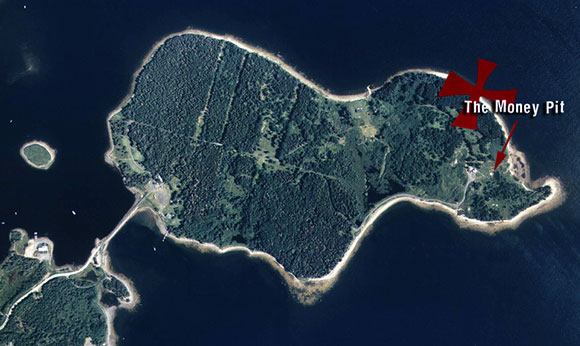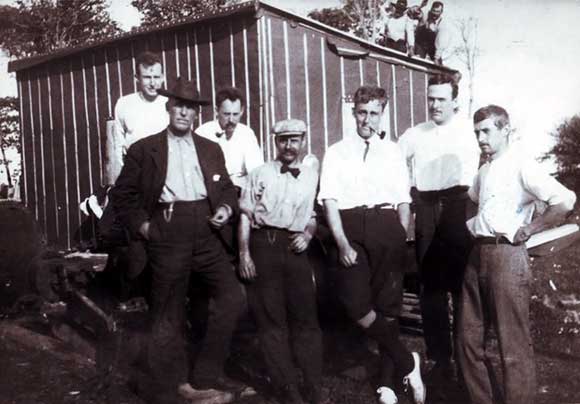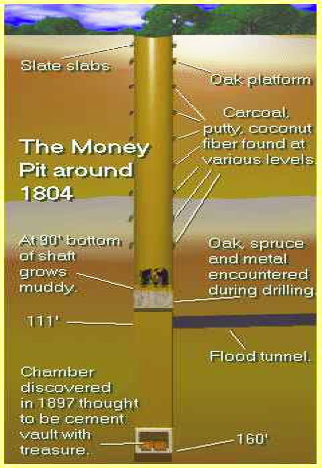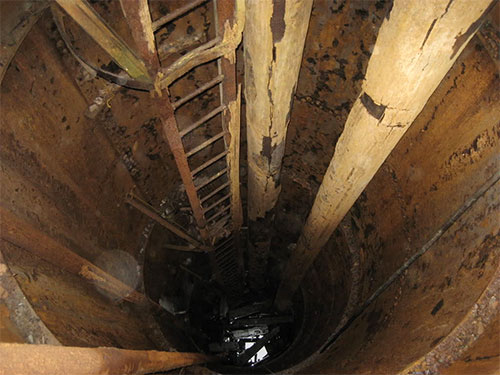by Capers Jones
One of the most curious human-caused mysteries of the past 300 years is the famous “Oak Island Pit” (aka The Money Pit of Oak Island) which has never been fully explained or fully explored, in spite of almost a dozen well-funded excavation attempts using fairly sophisticated equipment and professional engineers.
What has been found is an extremely sophisticated civil engineering project involving multiple lateral tunnels hundreds of feet long that feed sea water into a deep bore tunnel below a depth of about 90 feet.
Oak Island is a small island of about 140 acres off the coast of Nova Scotia in Mahone Bay. An image of Oak Island is shown below. The causeway in the lower left was built to allow excavation equipment to reach the island.

In 1803 a larger group with began to excavate again, funded by a man named Simeon Lynds. This was a group called The Onslow Company. This group also found layers of logs, and reportedly a stone slab with some kind of symbols on it:

This second group reached a depth of 93 feet and found the bottom getting muddy. Using a crow bar that they stuck in the mud they found what seemed to be a stone cover or slab at perhaps 96 feet, underneath the mud. This cover seemed to be about the diameter of the shaft. Since it was late in the day they stopped and planned to dig to the cover the following morning.
In the morning they found that the pit had 63 feet of water in it. The group tried to dig a second pit nearby but it filled with also, so they gave up.
Nothing much happened until 1849 when another group, the third, tried to excavate the original pit. This group was able to drill through the stone floor at about the 96 foot level and reportedly brought up a few links of a gold chain.
This third group found that the water in the pit was salty and went up and down with the tides. They explored the edges of the island and found a surprisingly sophisticated water trap. At a place called Smiths Cove about 500 feet from the pit were five stone water traps with coconut fibers and eel grass to filter the water. The five pipes came together into a single pipe leading into the pit.
Since coconut trees obviously do not grow in Canada this finding indicates a tropical location for some of the engineering gear. Interestingly, carbon dating showed the age of the coconut fibers to be between 1200 and 1400 AD. This does not mean that the pit was dug so early, because coconut logs and fibers might have been stored somewhere for perhaps hundreds of years before being transported to Oak Island. Even so the age of the coconut is an interesting mystery.
The group tried to divert water away from the pit and even built a coffer dam to keep water away from Smiths Cove, but the pit remained filled with water. This group ran out of money in 1851 and stopped excavation.
In 1861 a fourth attempt was made to reach the bottom of the pit by a group called the Oak Island Association. This group tried to pump the water out of the pit with steam pumps. But unfortunately a boiler exploded killing one worker and injuring several more.
The pumps could not remove water as fast as it was entering the pit. In 1864 this fourth group also ran out of money and stopped.
There were additional attempts in 1866, 1893, 1909, 1931, and 1936. None of them found the bottom of the pit but they did discover a second water pipe feeding water into the pit at about the 153 foot depth level. This pipe came from the opposite side of the island rather than Smiths Cove. The combined digging of all these groups made such a mess that the exact location of the original tunnel became obscured.
The Oak Island Treasure Company, the 1893 group, claimed to have found a vault at about the 150 foot depth. The vault was stated to be seven feet by seven feet and when drilled seemed to contain soft metal. The drill bit when withdrawn had a piece of parchment with the characters “VI” printed in ink. Other groups have not found any vaults.
One interesting historical note about the 1909 attempt: This was a group called The Old Gold Salvage Group and one of its members was future president Franklyn Delano Roosevelt. Roosevelt kept up an interest in Oak Island for as long as he lived. Shown below is a picture of this group with the young Roosevelt third from the right:

President Roosevelt is not the only famous person interested in Oak Island. The actors Errol Flynn and John Wayne also had an interest, and Wayne was reportedly part owner of one of the excavation groups.
In 1959 a group headed by Robert Restall and his son attempted excavations, only to find tragedy instead. Restall’s team was building a shaft to stop the water entering from Smiths Cove when the tragedy struck.
Restall’s son found his father unconscious in the bottom of the shaft at the 27 foot level and went to help, only to become unconscious himself. Three more workmen attempting to help also passed out. A visitor, Edmund White, who was a fireman suspected carbon monoxide poisoning from a pump engine. White had a rope tied to his waist to pull him up and was able to save one of the workmen, but the other four died before they could be removed from the shaft. After these deaths rumors began to occur about the “Oak Island curse.”
In 1965 a man named Robert Dunfield built the causeway to the mainland and brought over heavy equipment including a 70-foot digging crane. Dunfield attempted open-pit mining and dug a hole about 100 feet in diameter and 140 feet deep. He found a few porcelain shards but no treasure. Heavy rains slowed down the work and added to the cost, and eventually Dunfield ran out of money.
In 1970 another group called the Triton Alliance attempted a different approach of drilling a number of bore holes and sending down cameras. Apparently there are natural caves under Oak Island. Reportedly there were pictures taken of chests, but this is uncertain. An image from the web shows what all of these groups found between 1795 and 1970:

In 1995 the Woods Hole Oceanographic Institute did a survey of Oak Island. They found three natural tunnels in the area of the pit, and concluded that the flooding might have been due to natural causes rather than man-made water tunnels. The tunnels were found by using red dye which later was seen around the edges of the island in three places. Of course that does not explain the coconut fibers. Neither does it explain the layers of logs found in the pit itself, that clearly were placed their during the construction of the pit.
Between 1795 and today about a dozen formal attempts have been made to excavate the Oak Island pit, without finding anything more than perhaps a few gold links, a piece of parchment, a stone with carved symbols, an anchor, an axe, and some ceramic pieces. While digging tools such as a pick have also been found, they are more likely to have been left by some of the more recent excavators rather than the by the original crew.
After abour 230 years of attempted excavation that cost more than $20,000,000, involved more than 500 people, and cost six lives the Oak Island pit remains a mystery as to its origins and purpose and who constructed it.
Based merely on the depth of the pit and the dimensons of the tunnels and the sophistication of the water traps, it can be assumed that the pit complex was designed by one or more very capable civil engineers. Probably at least 100 workmen were involved in digging the pit and the water traps over a period of at least two years. In fact since Nova Scotia has long winters with snow and freezing weather, the construction of the pit may have taken more than two years due to the short outdoor work season when the ground was not frozen or snow covered.
This Oak Island pit was not a minor effort and probably exceeded the engineering skills of pirates such as Blackbeard and Captain Kidd. The Oak Island pit is a very sophisticated civil engineering project. The pit has been the subject of several books and even television shows such as one on the History Channel. A search on Amazon will turn up at least six books about the Oak Island pit.
In addition to the pit itself Oak Island also had what appeared to be a construction in the shape of a cross involving nine large stones. Whether these stones are related to the pit or were made by Native Americans is unknown. Some of the stones had drill holes about two inches deep and over an inch in diamter, for unknown purposes.
There are many hypotheses about who built the Oak Island pit and what it was built for. Some of these provide fascinating glimpses into history. Following are some of the theories as to the pit’s origins:
- One theory holds that the pit was dug by the crew of Blackbeard the pirate. Blackbeard was heard to boast that he had an underground treasure trove that could never be discovered.
- One theory holds that the pit was dug by Captain Kidd, another pirate, although he did not spend much time in Nova Scotia. (President Roosevelt’s camp on Oak Island was called “Camp Kidd” after this pirate.)
- One theory holds that the pit was used to hide the missing jewels of Marie Antoinette and was built by the French Navy. These jewels went missing from Versailles in 1791 and may have been taken from France by one of Marie Antoinette’s maids.
- One theory holds that the Pit was built by the French army to hold treasures from the Fortress of Louisberg after it was taken by the British in the Seven Year’s War. The idea was to keep the treasure away from the British.
- One theory holds that the pit was built by British Army engineers to hide treasure seized from the capture of Havana, Cuba in 1762. The Earl of Albemarle is cited in this theory.
- One theory holds that the pit was constructed by Knights Templar and holds not only their treasure but perhaps the Holy Grail and the Ark of the Covenant as well. Leaders of this order were arrested in 1307 and order dissolved in 1312. It was a wealthy order that provided banking services for much of Europe. Quite a lot of Templar treasure seems to have been spirited away and remains undiscovered; some of it may allegedly have been taken to Scotland and protected by the Sinclair family.
- One theory holds that the pit was constructed by the Scottish Earl of Sinclair who allegedly visited America in 1398 (see the picture of the Westford Knight in the section on the Newport Tower). Sinclair was allegedly a secret Knight Templar and hence might have had some of the missing Templar treasure, although this is denied by the modern Sinclair family. In fact the whole Sinclair trip to America is denied by Sinclair’s descendants. However there is a placque in Nova Scotia that asserts that Henry Sinclair discovered America and it is claimed that he visited Nova Scotia, which is where Oak Island is located. There is also a Prince Henry society in Canada. It is an interesting coincidence that the Prince Henry theory coincides with the approximate age of the coconut fibers used to filter the water traps leading to the pit.
- One theory holds that the pit was constructed by Masons due to what is claimed to be various Masonic symbols on the island and around the pit. Why the Masons would want to dig such a pit in unknown; unless as alleged Prince Henry Sinclair was a Mason.
- One very unlikely theory holds that the pit was built by Francis Bacon to hide documentary proof that he wrote Shakespeare’s plays. This is due to finding a piece of parchment with “VI” written on it in ink. This theory seems embarrasingly off base.
- One theory holds that the pit was built by Native Americans, probably the Micmac tribe who lived nearby. If so what it was built for is unknown since large deep pits are not common constructions among Native American groups.
- One theory holds that the pit is a natural sink hole and not of human construction at all. There are in fact natural caves and tunnels under Oak Island. However enough artifacts have been found in and near the pit to indicate that humans did build at least portions of the pit even if it is a natural sink hole.
Considering the amount of money spent excavating the pit it is unfortunate that the excavations have been so haphazard and done so much environmental damage to the area. At this point it is probably not possible to separate the original construction from the work of dozens of later excavation attempts.
As of 2014 much of Oak Island is privately owned and the government of Nova Scotia requires permits to dig for treasure. Some digging continues in 2014 but apparently is no closer to finding out the purpose of the pit as previous crews. Oak Island remains a curious puzzle that has attracted a great deal of interest for almost 220 years.
Copyright 2014 by Capers Jones
Links
- http://en.wikipedia.org/wiki/Oak_Island
- http://en.wikipedia.org/wiki/The_Curse_of_Oak_Island
- http://en.wikipedia.org/wiki/William_Kidd







